Reading Time: 8 minutesMicro SD cards are essential for smartphones, handheld gaming consoles, drones, and other devices where having a compact means of storage is crucial. But like every other storage device, they can still be affected by data loss. Fortunately, we can recover data from a micro SD card using a variety of methods.
In this article, we will talk about micro SD card recovery, how to do it from the comforts of your home, as well as what options are available if DIY fixes just don’t cut it. Let’s begin!
Important: Immediately after losing your files, stop using your microSD card to avoid overwriting the lost data.
How to Recover Files from a Micro SD Card on a PC
It doesn’t matter if your microSD card was used in a smartphone, camera, dashcam, drone, or any other device. The easiest and most effective recovery method is to use Disk Drill, a data recovery tool that works with all types of microSD cards regardless of how or where they were used. It scans the memory blocks of your memory card and analyzes their contents, and is capable of recovering files using both file system pointers and signature scanning of a wide range of files.
Note: Disk Drill version 6 includes an Advanced Camera Recovery mode, which can reconstruct fragmented videos from microSD cards used in cameras, drones, and DVRs.
- Download and install Disk Drill for Windows on your PC or laptop.
- Connect the microSD card to your computer via an external card reader or built-in slot.
- Open Disk Drill and select the card from the list of available devices. Click Search for lost data.
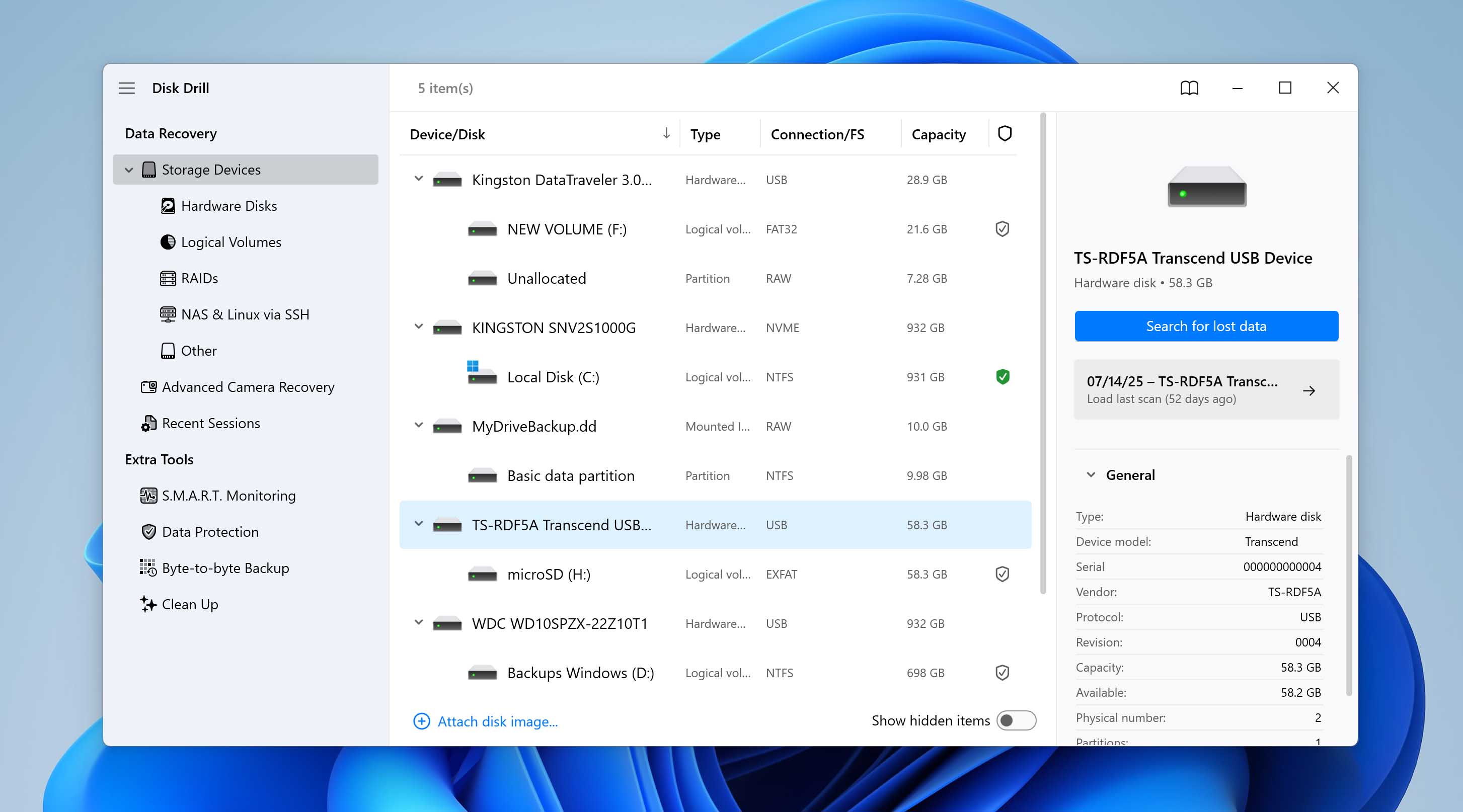
- In the pop-up menu, choose the scanning method: Universal scan for most typical recovery cases or Advanced Camera Recovery, which is specifically designed to restore unaltered videos from camera or drone memory cards.
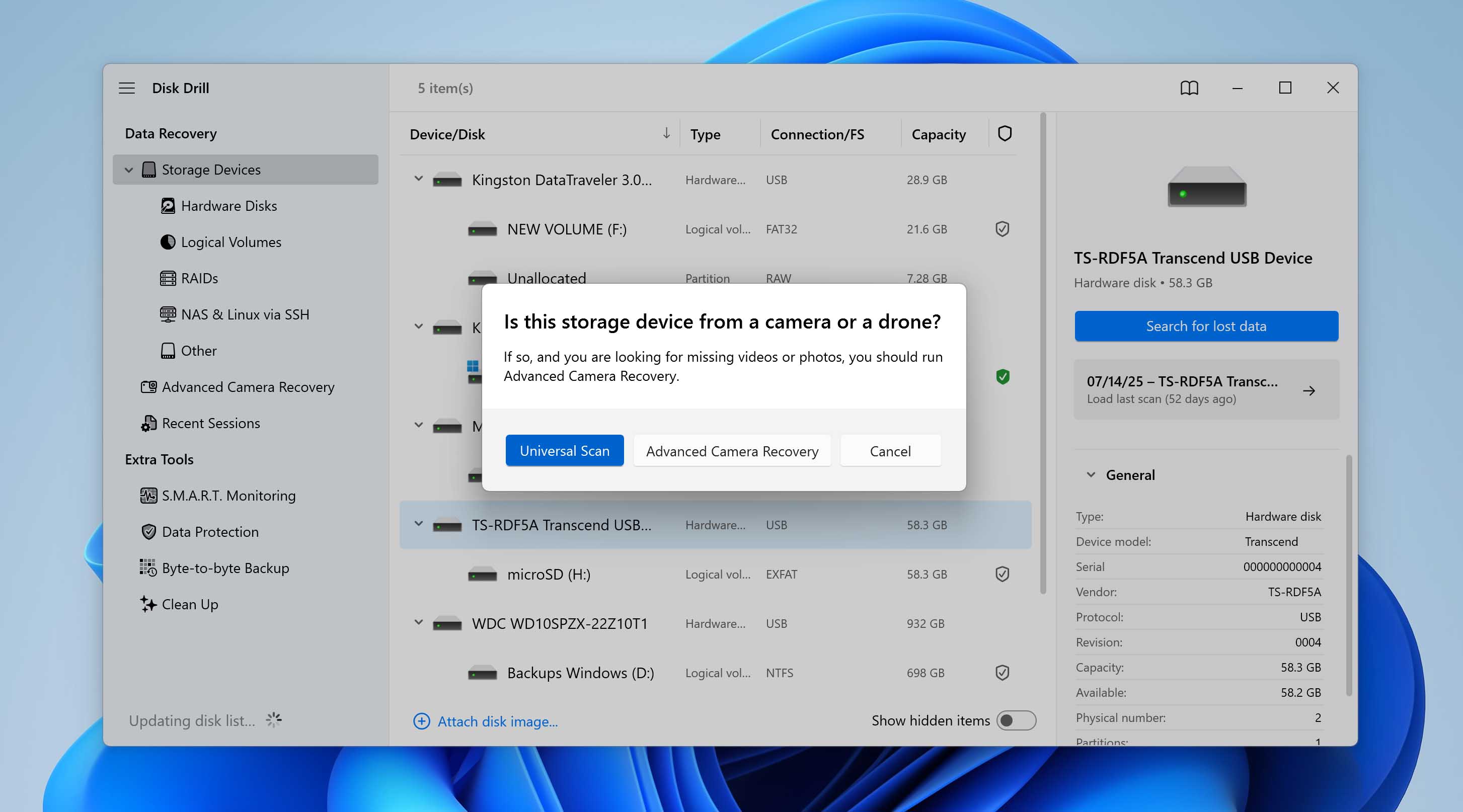
- Wait for the scan to complete and review the results.
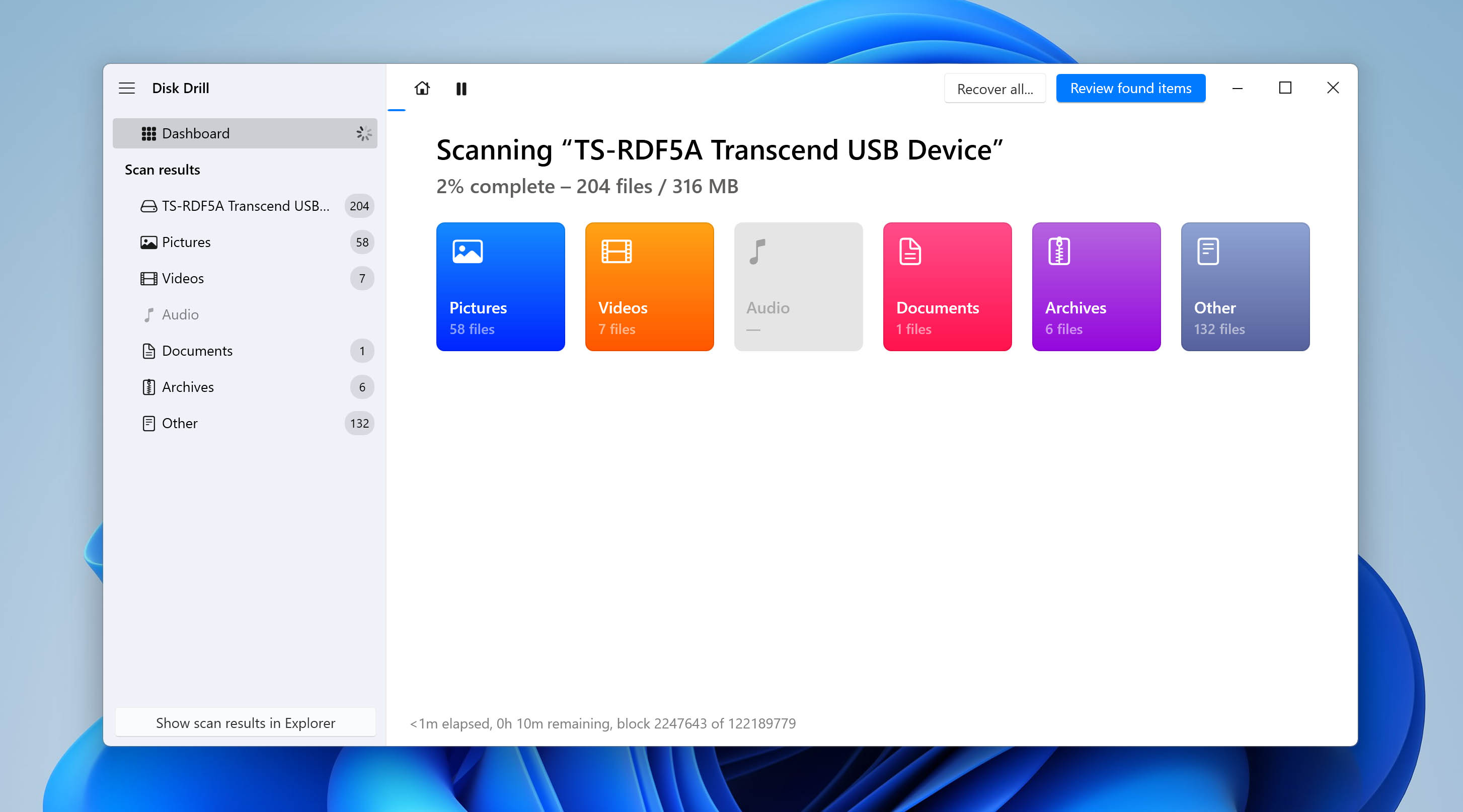
- Preview the files by clicking the eye icon. Select the items you want to recover.
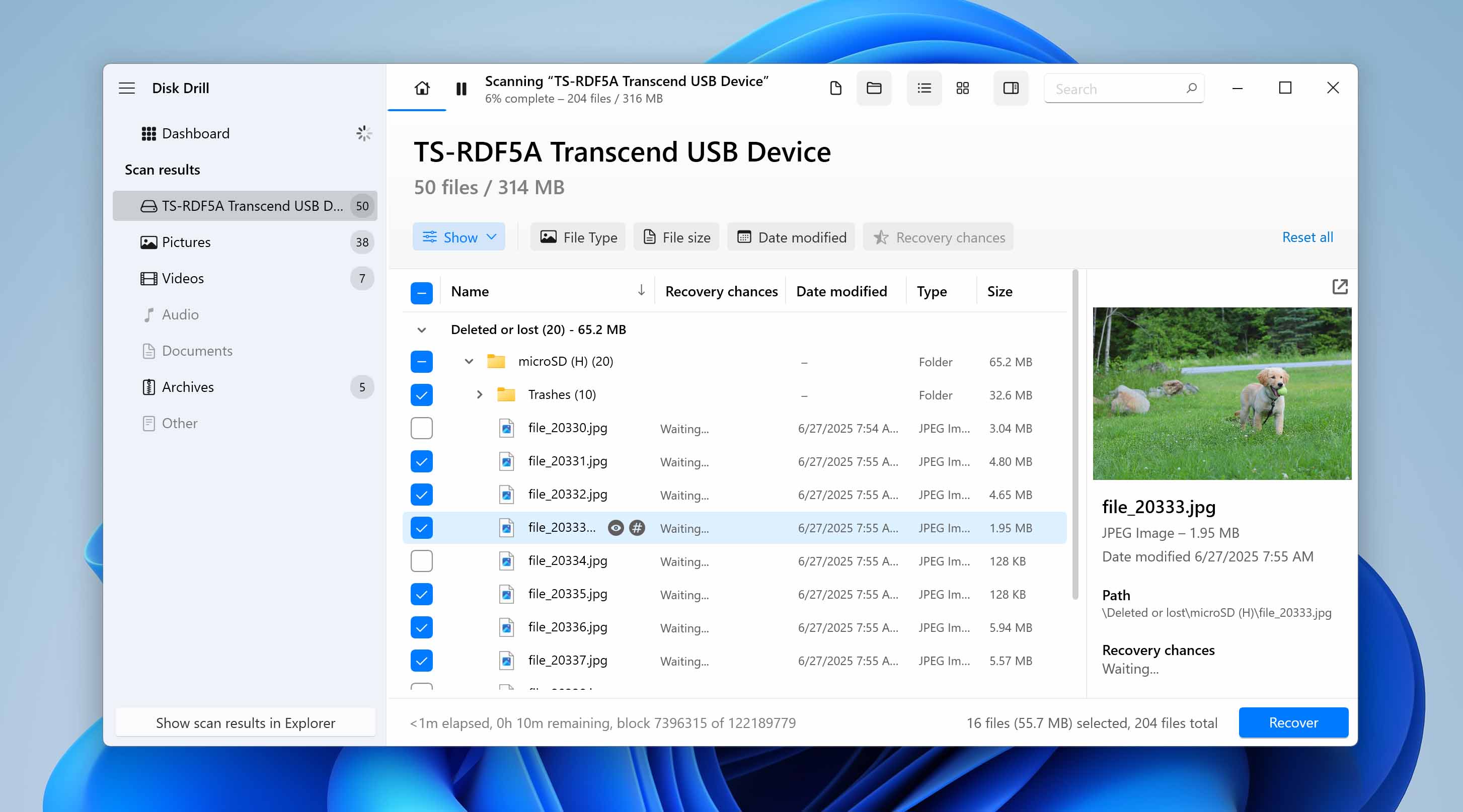
- Click Recover, then choose a location other than the microSD card to save the restored files.
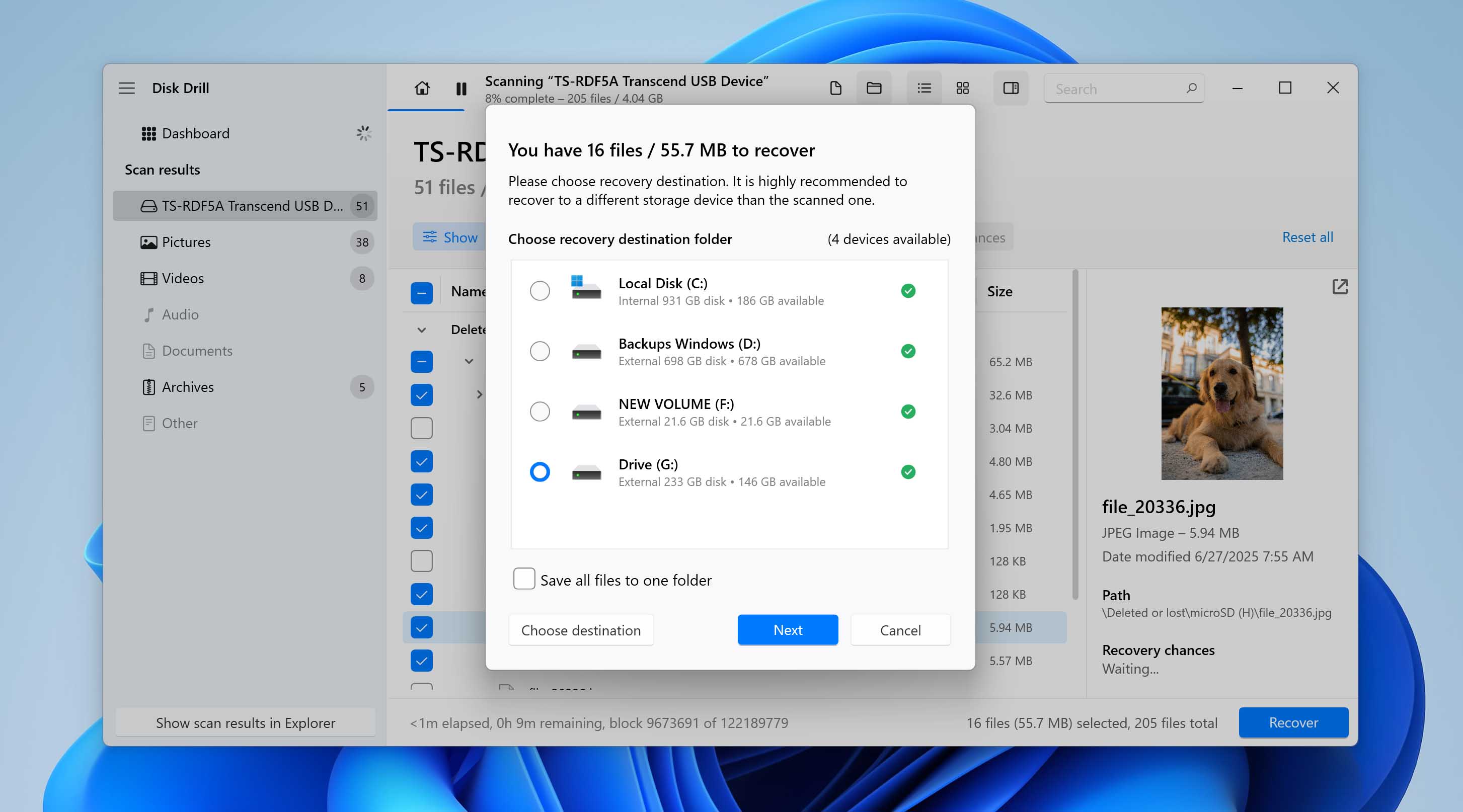
You can try Disk Drill with its free recovery trial version, which allows you to preview results and recover a limited amount of data. If you need to recover a larger volume of files, you’ll need to purchase the Pro version. It’s a worthwhile investment, as Disk Drill is capable of handling nearly all data loss scenarios—as long as your microSD card appears in Disk Management with the correct size.
How to Recover Data from MicroSD on Android
Since Android smartphones are designed to work directly with microSD cards, they provide additional recovery options beyond those available on a PC. In this section, we’ll cover two Android-specific methods that may help you restore your lost files.
Method 1: Check the Trash Folder
Unlike Windows PCs, many Android devices move deleted files from a microSD card to a Trash or Recycle Bin before permanently erasing them. This gives users an extra layer of protection in case they accidentally delete something important.
We’ll show you how to recover deleted files from the trash in the Files app. The same approach can often be used in apps like Gallery when recovering deleted photos stored on a memory card.
- Open the Files by Google app on your Android phone.
- Tap the Menu icon (usually three lines or your profile icon) in the top-left corner.
- Choose Trash from the menu.
- Browse the list of recently deleted items. You should see items deleted from your internal storage and your microSD card.
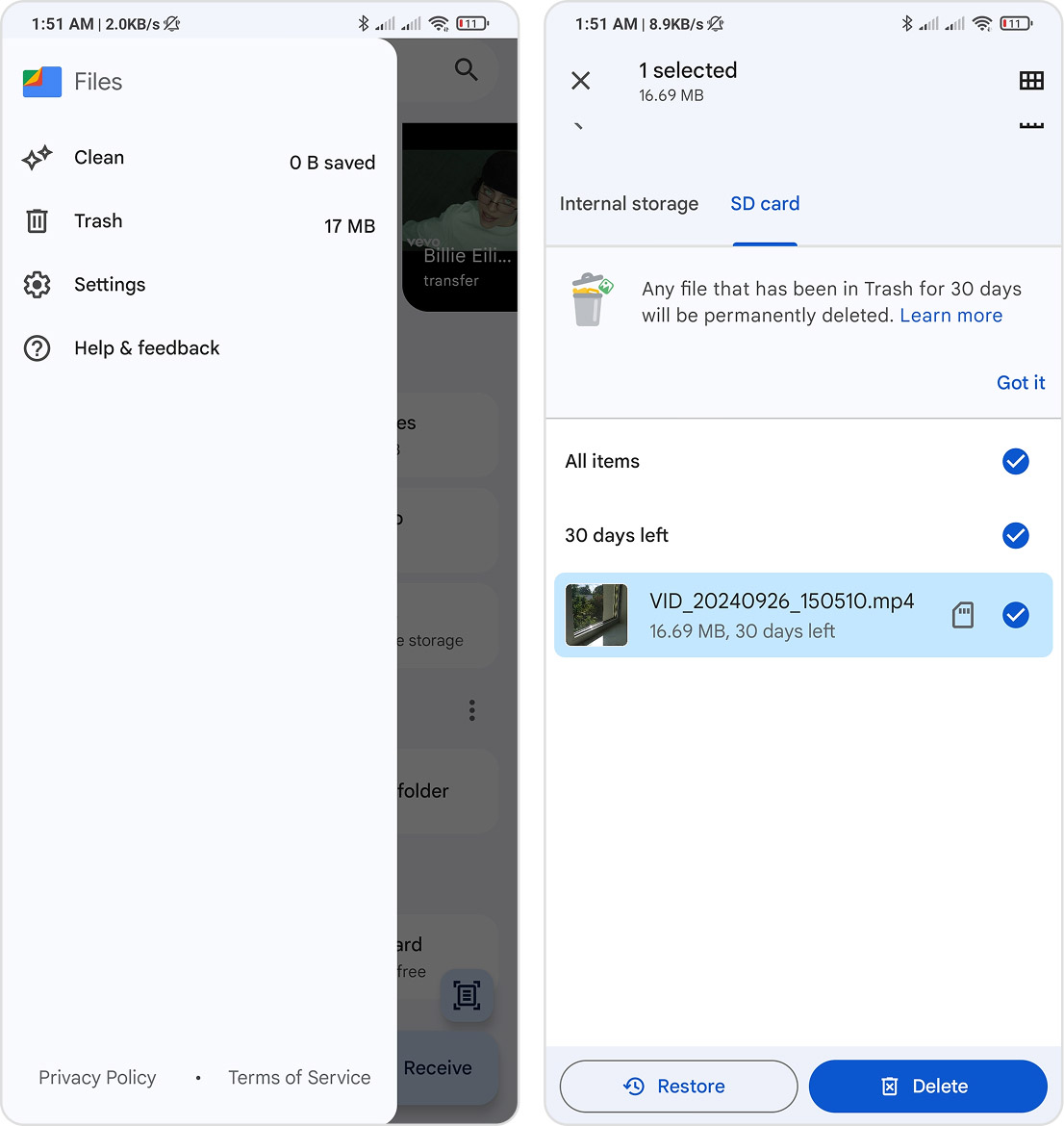
- Tap and hold the files you want to recover.
- Tap Restore to return them to their original folder.
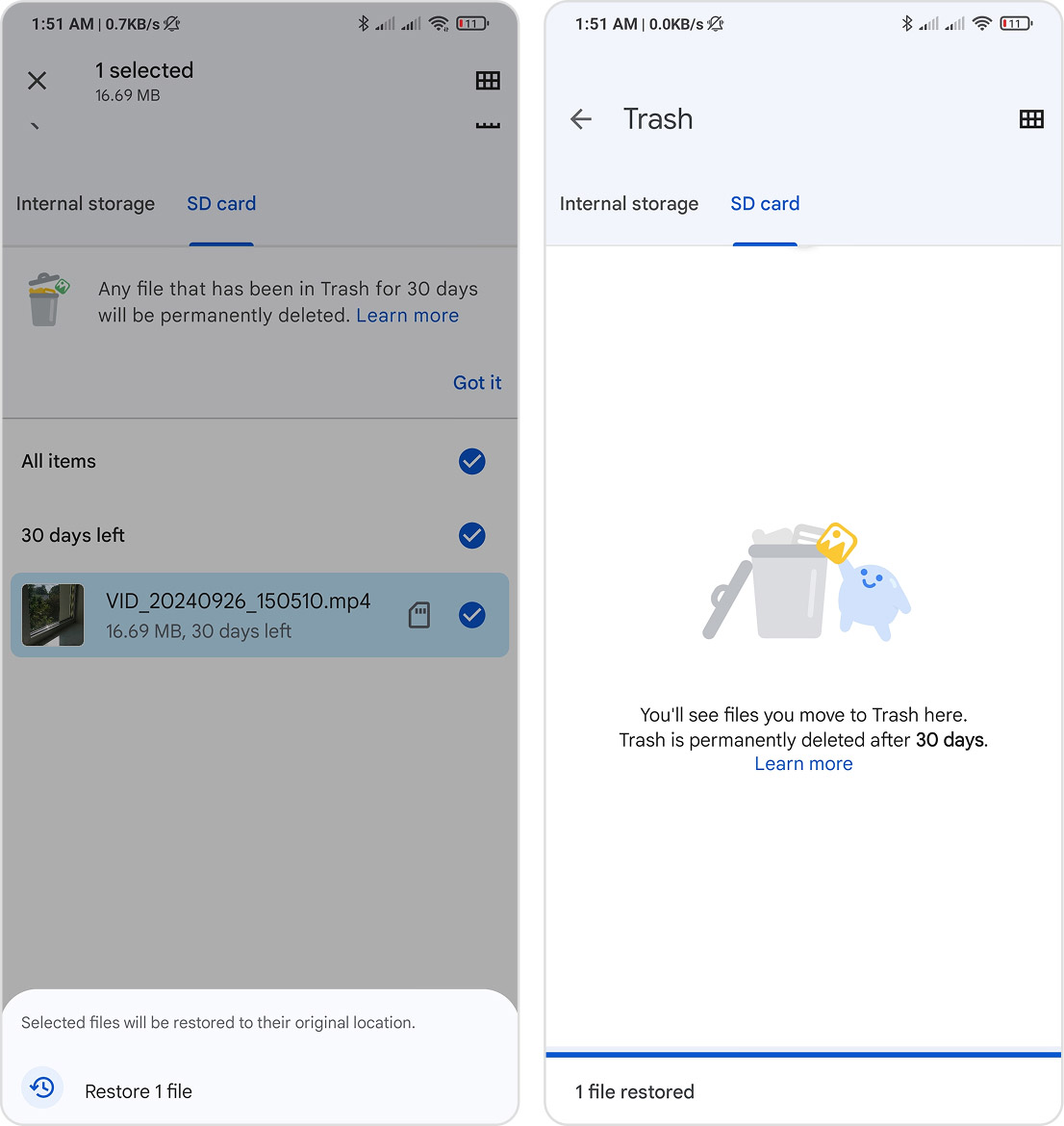
Attention: If you don’t see a Trash option, check the settings of your device or gallery app; some models require Trash to be enabled manually or may store it in a separate app-specific location.
Method 2: Use DiskDigger to Restore MicroSD Card Data
DiskDigger is a mobile app that allows users to recover deleted files directly on their smartphones. It offers a quick solution for retrieving lost photos and videos (only lost, not deleted) from a microSD card without needing a computer. However, there are some important limitations based on whether your device is rooted.
➢ If your Android phone is not rooted, you won’t be able to scan the microSD card separately. Instead, you’ll need to use the Basic scan, which searches all available storage. This method only recovers reduced (not original quality) versions of deleted photos.
➢ If your device was already rooted before the data was lost, DiskDigger can perform a Full scan that lets you select the microSD card specifically and recover more file types, including photos, videos, and documents.
- Download and install DiskDigger on your smartphone.
- Launch the app. You will then see two options: a Basic scan and a Full scan. If you choose the Full scan, you have the option to limit the search to just the micro SD inserted in your phone.
- Select the file types you wish to recover and let the app run the scan.
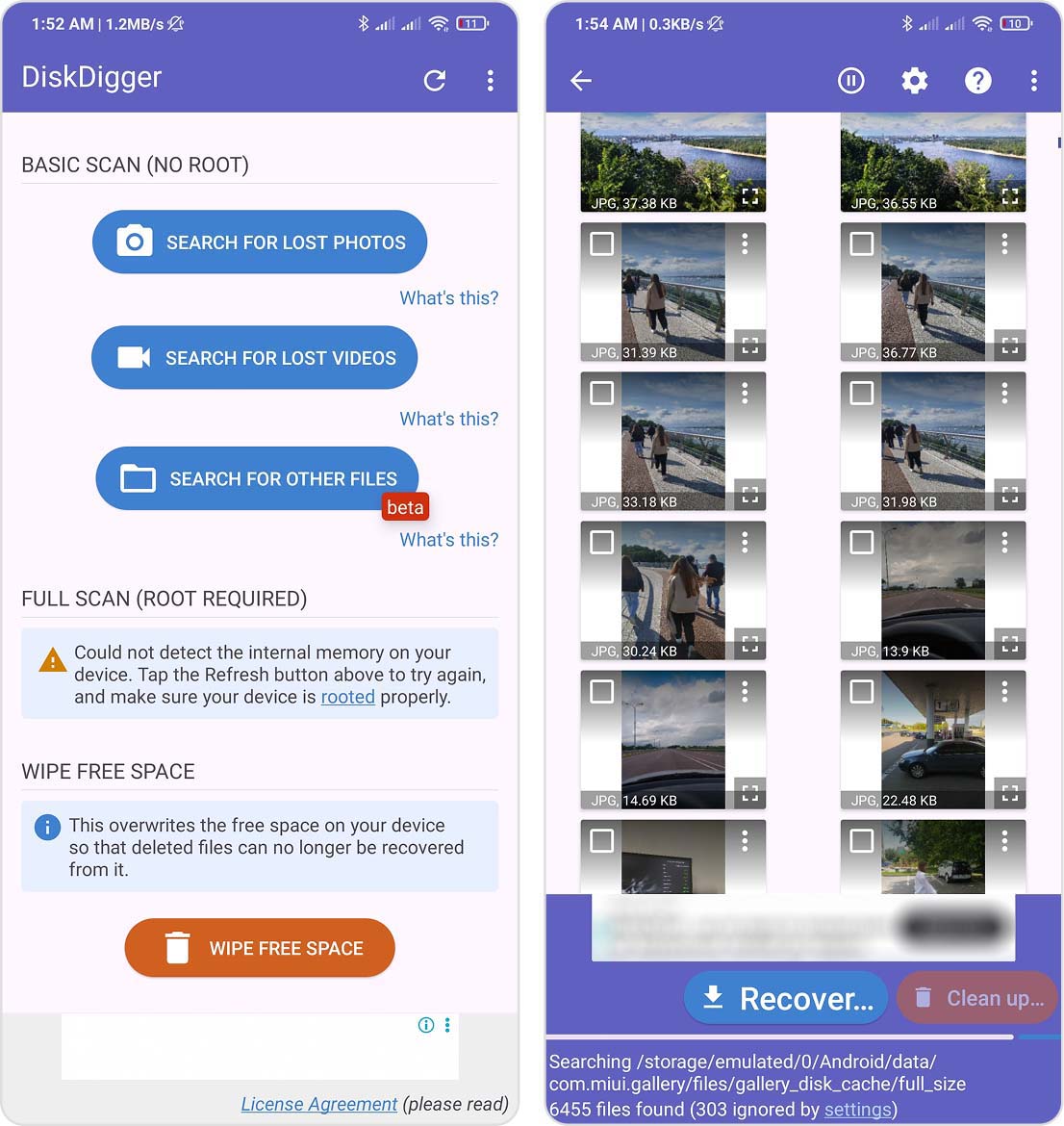
- Tick the boxes of the items you want to retrieve, then tap Recover.
- Choose how you want to save the recovered files. You can save them locally, upload them to an app like Dropbox or Google Drive, or upload them to an FTP server.
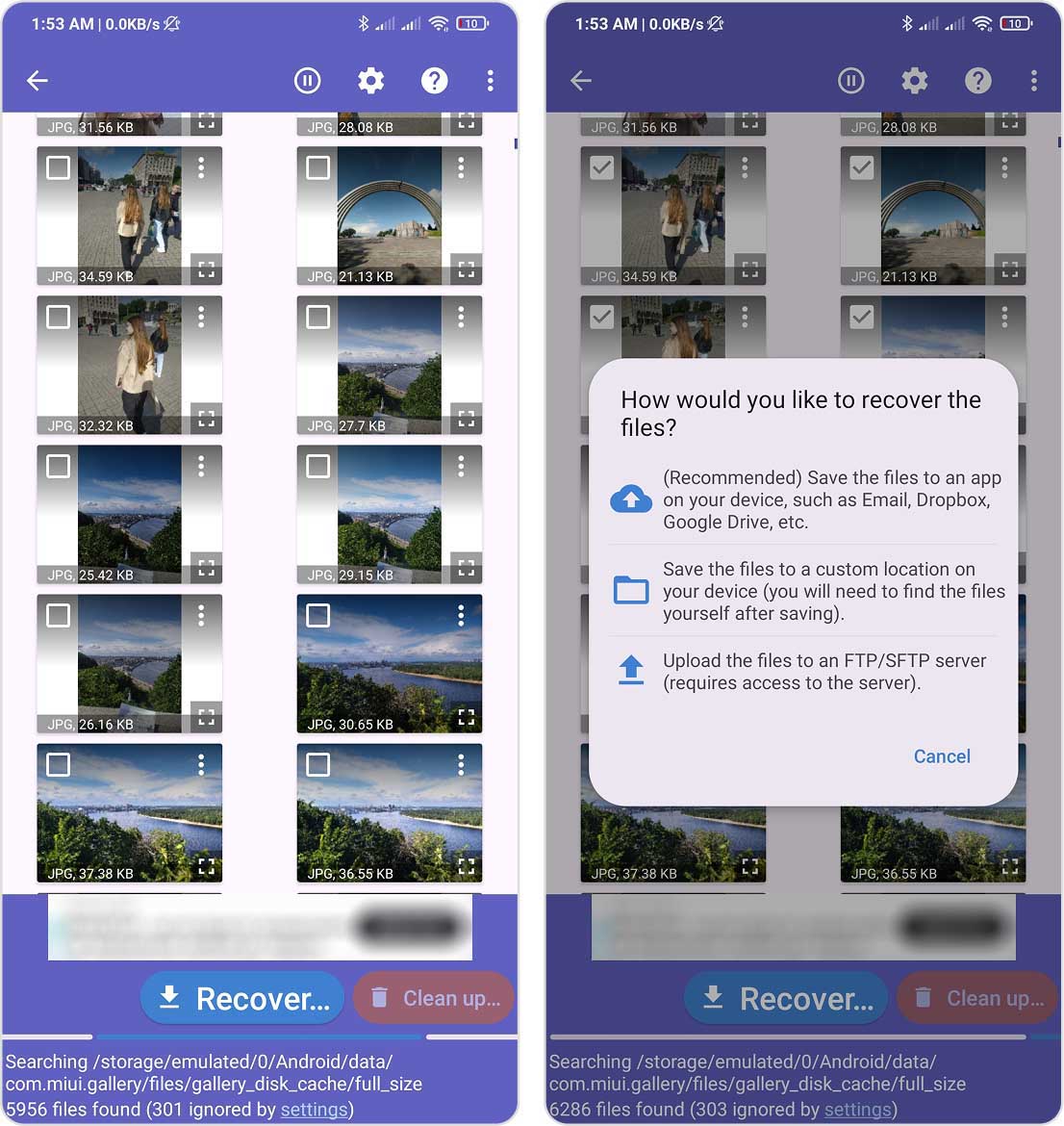
Common Problems with Micro SD Cards and How to Fix Them
Your micro SD card’s functionality may be adversely affected by a number of different factors. We listed some of the most common micro SD problems, as well as the corresponding solutions, below:
🔍 Micro SD Card Not Recognized
When your micro SD card is not recognized by your device, there are three possible causes:
- Dirt or dust is hindering your SD card from being read properly. In this case, gently wipe it clean with a soft cloth, then try again to see if this solves the issue.
- Your micro SD card might also be unrecognizable due to physical damage or corruption. Check the next two subsections for more information on these particular situations.
- Your device’s memory card slot is defective. To check if this is the case, insert the micro SD card into a different computer or smartphone. If it works, then the problem lies with the original device.
🔨 Physically Broken
Physical damage may be caused by exposure to heat, water, electrical charge, or mechanical sources of damage, such as when you accidentally step on a delicate memory card. Unfortunately, a physically damaged micro SD card is beyond salvage. But though it cannot be restored back to normal function, it’s possible to retrieve files contained therein with the help of professional data recovery services. They have all the tools and software available to recover your files from microSD cards with the highest chance of success.
❌ Corrupted
If your microSD card seems to have problems with file transfers, access errors, or reading delays, you can try using the built-in chkdsk command line tool on Windows. This utility can help repair basic file system errors and improve access stability.

However, if the issue stems from a corrupted file system (for example, the partition appears as RAW or can’t be opened at all), you’ll want to use a more advanced tool like TestDisk. TestDisk can repair partition tables and restore lost or damaged file systems—but be careful, as incorrect use could lead to further data loss.

🔐 Encrypted
Unless you have the decryption password, you won’t be able to use or access data from an encrypted micro SD card. The good news is, there are third-party decryption apps available online for you to try. If you simply want to be able to use the micro SD card again and don’t mind losing the data therein, using the DiskPart command is also an option to format it.
🖋️ Write Protected
Are you using an SD card adapter with your micro SD card? If so, then you might have the write-protection switch turned on.
Most regular SD cards and micro-SD-to-SD adapters are designed to come with a small switch that prevents memory from accidentally being deleted or overwritten. The solution is as simple as switching write protection off. Sometimes, you might have to toggle it on and off a few times for it to work.
📚 Wrong Capacity
Micro SD cards having slightly less available storage than advertised is completely normal. For example, a 64 GB micro SD card with 62.4 GB of actual usable memory is nothing to be alarmed about. But if the capacity displayed by your memory card is way off, then it’s probably corrupted. In this case, back up all important content, and then format the storage device.

Conclusion
Our main advice is that you should first understand the situation you find yourself in. Ask yourself: is the card still readable by the system? Was it used in a camera, phone, or drone? These answers will help you choose the right approach from this article.
If the card still shows up with its full capacity, you’re in a good position — stop using it immediately and scan it with professional recovery software. If it’s acting strangely, CHKDSK or TestDisk might help. And if it’s not recognized at all, physical damage or controller failure may be to blame, in which case you’ll need expert help.
FAQ
- Download and install Disk Drill.
- Launch the app, select your micro SD card, and initiate a scan.
- Choose the files you want to restore, then click Recover.
- Choose a suitable recovery location and wait for the process to finish.













